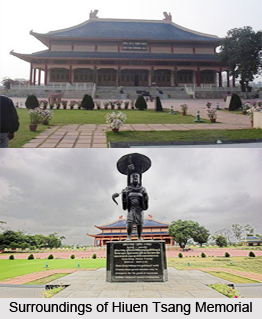 Hiuen Tsang Memorial is one of the major tourist attractions in Nalanda. Now this memorial has the temple related to Buddhism and the research centre on Indian early history.
Hiuen Tsang Memorial is one of the major tourist attractions in Nalanda. Now this memorial has the temple related to Buddhism and the research centre on Indian early history.
Erection of Hiuen Tsang Memorial
Hiuen Tsang Memorial is erected in the memory of the famous Chinese traveller Hiuen Tsang.
Glorious Days of Nalanda
Hiuen Tsang came to study Buddhism and mysticism in India from China. He came in India in 633AD that is during the Gupta period and stayed at Nalanda University (now in Nalanda District) for twelve years. He travelled the whole India during his stay at Nalanda.
Hiuen Tsang
Hiuen Tsang was a compulsive traveller; he travelled extensively the whole of India. He visited Takshashila, which was a Buddhist centre of learning for further extension of dimension of his learning.
Nalanda University and Hiuen Tsang
According to the history of early India, Hiuen Tsiang`s visit to Nalanda Mahavihara was towards the fulfilment of his life-long wishes. He ever wanted to study in India and learn Buddhism. He appreciated Indian hospitality and ambience for study and profound learning. He learned Buddhism and Yoga from Shilabhadra and Buddhabhadra. Both the teachers who taught him were of great intelligence and Hiuen Tsang learned the study of medicine, crafts, linguistic, and craft from Nalanda University.
Returning from India
Hiuen Tsang returned to China in 645 AD and he opted for the same route from which he had come. On his way to China he lost many crucial documents which were highly relevant for Buddhist studies. On his way to China he stayed at Kusha and Kashghar monasteries and collected some documents and information relevant for Buddhism which he had lost in Indus River. On his return to China, the emperor built a pagoda at the southern gate of the Hogn-Fu temple in Si-gan-fu and entire collection of Hiuen Tsang was kept and protected in it.
Collection of Hiuen Tsang
Hiuen Tsang had collected relics, golden and sandalwood statues of Gautama Buddha, 224 books of the sutras, 192 Shastras, 15 works of the Sthavira schools, 67 books of the Sarvastivada School, and 17 works of the Kasyapiya School to take to China. After seeing Hiuen Tsang, Chinese emperor got upset because of his learning of different religion. Later on the king accepted him and gave him royal welcome in the capital of the state and built a library to keep all the documents gathered by Hiuen Tsang in it, which are relevant source of historical writing on Buddhism.



















